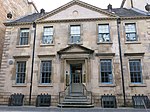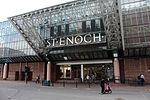Argyle Street railway station
Pages with no open date in Infobox stationRailway stations in GlasgowRailway stations in Great Britain opened in 1979Railway stations opened by British RailRailway stations served by ScotRail ... and 2 more
SPT railway stationsUse British English from January 2018

Argyle Street railway station is a station in the City Centre of Glasgow, Scotland, on the Argyle Line, which connects the North Clyde lines at Partick with Rutherglen in the south-east of the city. The station is located below the thoroughfare whose name it bears. It has a narrow and often crowded island platform. It serves the Argyle Street shopping precinct as well as the St Enoch Centre. Along with Dalmarnock and Anderston, no services call at this station on a Sunday before 10am or after 6pm.
Excerpt from the Wikipedia article Argyle Street railway station (License: CC BY-SA 3.0, Authors, Images).Argyle Street railway station
Osborne Street, Glasgow Merchant City
Geographical coordinates (GPS) Address Nearby Places Show on map
Geographical coordinates (GPS)
| Latitude | Longitude |
|---|---|
| N 55.857 ° | E -4.251 ° |
Address
Osborne Street
Osborne Street
G1 4AB Glasgow, Merchant City
Scotland, United Kingdom
Open on Google Maps





